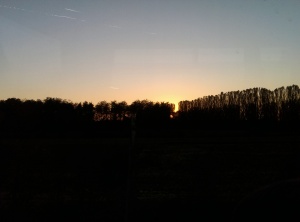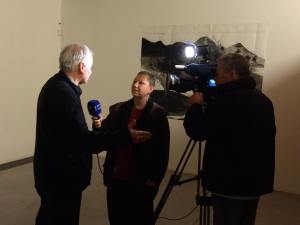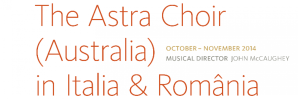
Travelling east from Venice, one enters the autonomous region of Friuli-Venezia Giulia. Vast plains stretch eastward to the Slovenian border. In the extreme East of the region, the capital of Trieste opens Central Europe to the Adriatic Sea. The plains also reach northward to the towering mountains that form a natural border with Austria. Water rushing down from the mountains forms the Tagliamento, which divides the region in two. Along this river lies Camino al Tagliamento, a beautiful town sporting one of the richest musical cultures in the region and, following extensive research by the choir, some very fine wines.

As our bus rolled into Camino, the setting sun flashed through rows of trees and over vineyards. The red roofs and distinctive brickwork of the region expand out from the town centre, which consists of a blazing yellow villa and a library. Beautiful old bicycles dot the roadside. The locals see no problem with leaving them propped up on the curb when they go inside. The area is strongly bilingual, with signs written in both Italian and the local language, Friulana. The local library also served as the venue for much of the town’s contemporary music festival, Camino Contro Corrente (Camino Counter-Current). The library features a beautiful and intimate new auditorium, one of the town’s two modern performance spaces.

Camino’s performing arts culture is the result of generations of local teachers and practitioners. The composer, conductor and musicologist Davide Liani grew up in the town and went on to become director of the Conservatorio Benedetto Marcello in Venice and Palermo. He continued to teach and organise master classes in Camino throughout his life. The town was also home to the renowned Zanin family of organ makers. The festival concluded, according to tradition, with a recital of opera arias by the Camino-born soprano Francesca Scaini, who has maintained an international teaching and performing career.

The powerhouse of contemporary music in the region is the Zorzini family, including the gifted twins Francesco and Carlo. Francesco spearheads the festival, rallying the town to support the concerts and musicians. Members of the community took turns to help cook for the three-dozen members of the choir every lunch and dinner. This was not an easy task and the choir was amazed and grateful for the stream of pasta, polenta and meat dishes that regularly emanated from the small kitchen of the parish centre. A drop of grappa, possibly drizzled over a slice of local raisin cake, usually concluded the long meals (and led to some interesting intonation in rehearsal). Francesco further rallied a team of drivers—including the indefatigable Daniele (“Dalmato”/”Biscuits”) Locatelli—to ferry the choir from their digs on opposite sides of the town. One had the impression, talking to the locals, that any young person in the town could scribble down a fugue or a chorale, if not generate a body of original, contemporary compositions.
Strade dell’Este

The theme of this year’s festival was “strade dell’Este” (roads from the East). The festival included another concert by Gisbert Watty and Frauke Aulbert, who performed two beautiful Greek songs by Stefan Hakenberg. Aulbert’s rendition of the curved lines of Scelsi’s famous piece for solo voice, Hô, was utterly entrancing in the complete darkness of the auditorium. The pianist Erato Alakiozidou performed her muscular programme of contemporary Greek piano compositions. Some more laid-back pieces included the meditative Remaining Sounds of a Deep Sea by Calliope Tsoupaki. A pleasant surprise in the festival was Nicola Ventrella’s solo recital of piano works by Kaikoshru Shapurij Sorabji. Ventrella performed six of the 100 Transcendental Studies, which are amusing in their use of a mundane form with such grand ambition. It is truly a pity that we do not have the opportunity to hear the longer piece St. Bernard de Comminges (“He was laughing in the tower”) more often. It juxtaposes textures like a Messiaen piece, but the harmonic language is more traditional. Chorales and eerie counterpoint give way to thunderous chords and figures that range across the keyboard from the resonant bass to (in this case) the humorously-puny treble.
Astralians

What better place to explore the theme of East and West than Camino, which sits along the easiest land route from Western Europe to the East? What better way to explore this theme than to invite an Australian choir? An Australian choir is appropriate not because we are geographically (according to most maps) very far to the East, nor because Australia is a melting-pot of Western and Eastern cultures, but because Australia’s remoteness works as a sieve that collects a unique arrangement of cultural artefacts from the rest of the world. In Australia, distance works like a telescope, blowing certain works out of proportion and filtering out others. Think of a window made of hundreds of small lens-shaped bubbles or panels. I’m not making the old argument that one’s perspective distorts the cultural landscape, but that objects like musical works make their way relatively intact into the Australian context in differing proportions. The major works repeated over and over again on the international stage are often sieved out and, in relative silence, the value of lesser-known works becomes evident. Which other choir in the world would find the time to sing so many works by two composition teachers and their current pupils, then travel to Camino to perform them?

Astra had the good fortune to present three concerts, including the magical performance of Riccardo Vaglini’s Inventario mentioned in the previous blog. The other two concerts were sacred and secular respectively. The sacred concert in the Chiesa di Oggnisanti gave us the opportunity to perform Francesco Zorzini’s own Libera me, a subtle and beautiful piece. From opposite sides of the church, the choir intones on slightly-shifting chords. Slight rhythmic modifications in different parts produce a heterophonic effect before the choir suddenly drops to a whisper. Swelling syncopations and a counterpoint of different note values is used to vary the otherwise stern, flat texture. Gianluca Geremia, a young composer from Venice, was also in attendance to hear his Agnus Dei. Geremia explained to me over a plate of pasta how the expansive piece, with its long, stretching phrases, originated from a harmonic idea and was then shoe-horned into the Agnus Dei text (or, rather, the other way around). The choir performed Filippo Bresolin’s O magnum mysterium, once more trying to manage its transition from spoken to sung voices amidst a difficult tempo change. It is one of the most difficult moments for the choir, along with the intonation of the exposed, perfect intervals at the start of Gianandrea Pauletta’s stunning Hoc Est. The concert ended with the rollicking hit Pastores loquebantur by Clemens non Papa—something nice to walk out the front door to. Though the night was cold, the audience willingly followed us out into the street.

After the mammoth sacred concert, we were up early for our secular programme in the small amphitheatre. It was a very rewarding chamber music space to sing in, as one could hear the rest of the choir perfectly. As well as showcasing much-loved classics like Schoenberg’s Mond un Menschen, we were also able to air a few more Australian compositions, including Lawrence Whiffin’s playful Revolutionary Fugue and Keith Humble’s Nocturne III. Humble’s piece, dedicated to John McCaughey, is based on a ninth-century Chinese poem full of images of homesickness. The final line, implying a sunrise, is painted with a series of saturated chords that the choir held as they moved towards (but not out) the door.

On our last night in Camino, the choir was graciously hosted by the Scaini family. If the delicious dinner of local specialties was not enough, we were thanked with a local Friulana song. During his speech, John mentioned the mysterious aura of Camino. I couldn’t agree more. The humid atmosphere (relative to Melbourne!) and earthy smell of the fallow, fertile fields give the air a lucid, expectant quality. The sun shines upon the town from dawn to dusk, occasionally coloured by clouds and haze. We often walked by the farms and vineyards to rehearsal and every step was intoxicatingly beautiful. Even the roadside ditches have a certain poetry about them. Then there are the people. After the touristic bustle of Venice, it was wonderful to arrive somewhere that was going about its own business quite independently of your intrusion. It was as though we were watching the town through a screen—no doubt compounded by the language barrier of Friulana—until somebody reached out and said “hello.” This feeling was strongest when we left the church on the eve of All Saints’ Day. The town was silent, the streets were empty, but the graveyard was festooned with flowers, torches and candles.
-Matthew Lorenzon
Matthew writes the Partial Durations contemporary music blog with support from RealTime Magazine.

Thanks for this eloquent travelogue of Astra’s journey west. As a regular follower of Astra it is great to hear details of your trip and to hear of places where music and singing is really part of the culture.
LikeLike